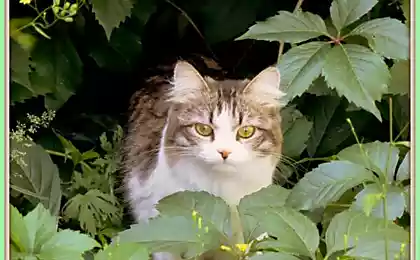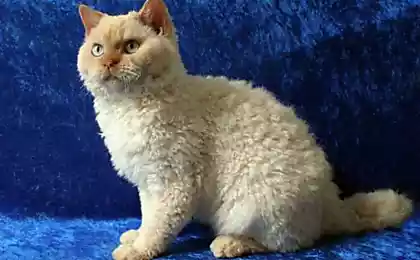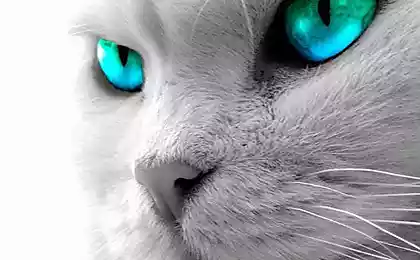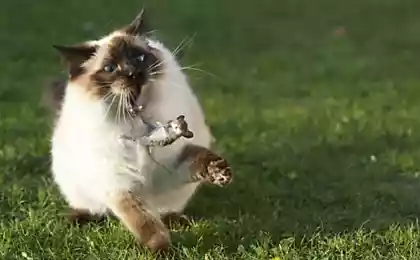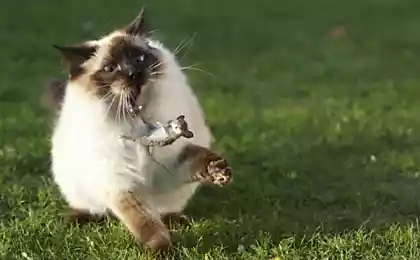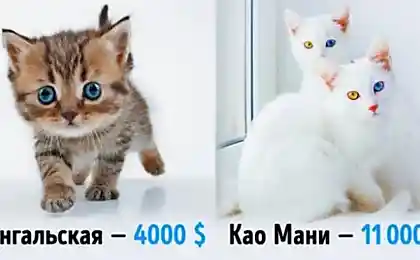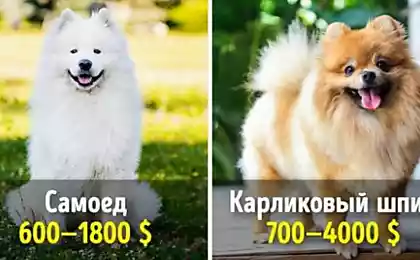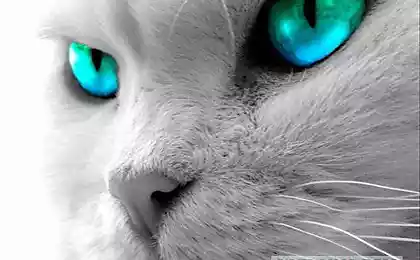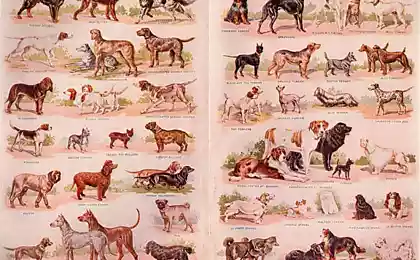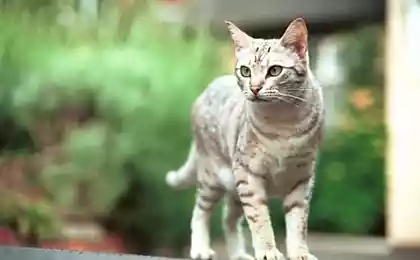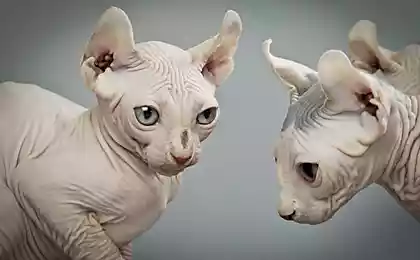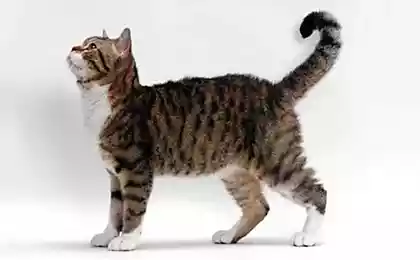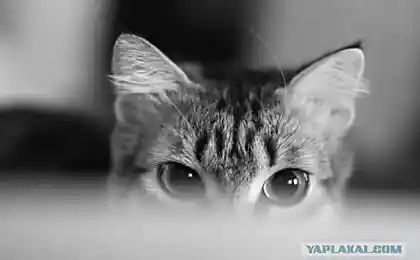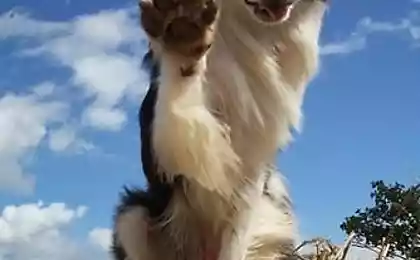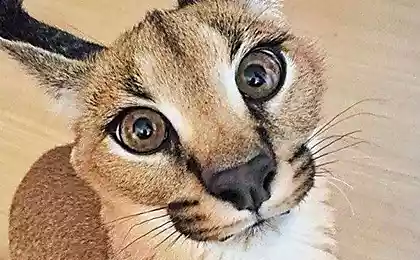2518
Breed cats. Part 2
Good day, dear, YaPovtsy !!!
As promised, we continue to get acquainted with the world of cats and with all its diversity. For the second part, I picked up the 10 breeds of cats that I am personally interested in, and I think will interest you too. Well, let's go !!!
There will be 48 pictures

1. Neva Masquerade cat
Neva Masquerade cat - a breed of long-haired cats with color-Pointed color and bright blue eyes. In fact, the Neva Masquerade cat - a cat Siberian breed with color, like the color of the Siamese. This breed is the pride of Russian breeders, but in other countries there are many nurseries where they grow Neva Masquerade cats.

2. Neva Masquerade cat
The name of the Neva Masquerade cat was due to his mask on the face, which makes it similar to a beauty, gathered at the masquerade.
The breed is fairly large, the weight of an adult cat is reached about 5-6 kg. Weight adult cat is much more about 8-9 kilograms.
Colors Neva Masquerade cats can be quite different. The most common color of the breed among cats - seal point, ie, light body and dark brown, sometimes almost black, Point (feet, tail, ears, muzzle). Sometimes Neva Masquerade cat color seal point are unique due to darkening in color. Very many people like a shade, and sometimes in the nursery are asked only of "shaded" cat.
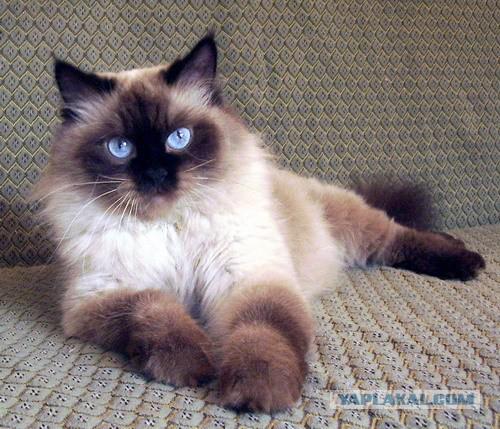
3. Neva Masquerade cat
Eyes Neva Masquerade cats can have different colors, from light blue to sapphire blue. Some cats of this breed are rather gentle and good looking and very comely muzzle. At the same time it does not meet the requirements of the breed, but like many fans and owners of Neva Masquerade.
Wool Neva masquerade cat is worthy of attention. Like the Siberian cat Neva Masquerade wool does not cause allergic reactions in sensitive doge allergies. Therefore, if your family has a person suffering from an allergy to wool, and like to have a pet, we recommend that you pay attention to the Neva Masquerade cats. But that's not all resemblance to the coat of Siberian cats. Wool masquerade cat repellent, smooth and does not require special care for themselves, as It never slips and does not form tangles. Another feature of the coat of this breed, inherited from the Siberians available wool collar and panties on his hind legs.
Neva Masquerade cats are very beautiful, and always will cause the admiration of your guests. The animal is aware of its beauty, and will seek to show itself at its best, is shown at the right time, nicely fluffed up and walk next to the guests.
Cats of this breed in the spring molt begins. Animal "undress" a fly takes off unwanted undercoat. By the winter undercoat grows again and again becomes a cat furry and fluffy.
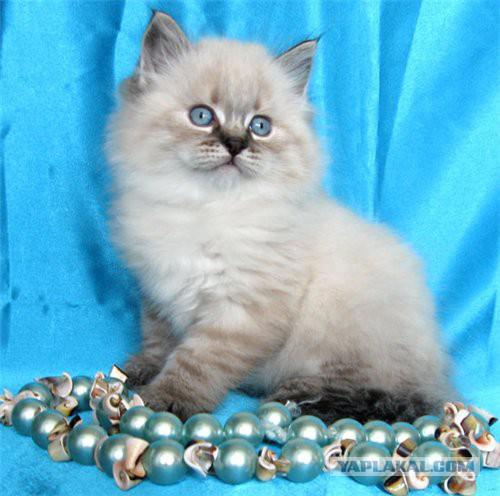
4. Neva Masquerade cat
Neva Masquerade cat is suitable for those who want to have a pet in the house, gentle as a cat and devoted dog who needs a good friend and companion. Cats of this breed is very attached to their owners, like dogs differ a great devotion. The house and furnishings for the Siberian cat Neva stand in the background, the main thing for them - to receive love from their masters. Thus Neva Masquerade cat did not suffer persistence and long-winded, and will constantly climb to his knees for caresses and plaintive meow. This animal senses your mood and come to you only when you are in a good mood and when ready to caress it and play. Loneliness for these animals is not a disaster. You just came from work, little play and cuddle your favorite Neva Masquerade - and this for him is enough.
Neva Masquerade cats are playful and active, but in moderation. Temperament they did not allow excesses. They bring to any home the feeling of comfort and peace, at the same time arranging a physical workout.
Resentful of these cats is completely absent. They will never write to you in the shoes or defecate on the carpet, if you punish them. If a Neva Masquerade cat you would be offended, it just turns back to you and telling you a hint that you are unfair to her. For the care and affection these cats always answer the same coin.
Another remarkable feature of the Neva Masquerade cat: she knows and remembers your name! To lure her to his simple "kitty" you are unlikely to succeed. But when he heard his name, the cat is sure to respond. This breed, unlike many others, understands not just your tone but your words.

5. The Russian blue cat
In Russian blue cat - elegant beautiful body, narrow skull and wedge-shaped head that distinguishes it among the relatives of other breeds. The main feature that distinguishes this breed - short shiny coat uniform blue color with a unique silvery sheen.
Wool cats breed "Russian Blue" differs from other breeds hair: guard hair and undercoat from the Russian blue cats of the same length. On the body the hair is short, like a plush, very thick - skin it is impossible to see through.

6. The Russian blue cat
Russian blue cat - a peaceful, kind and always listen to the owner, but apart from that it is a little bit stubborn and loves freedom. Shy and secretive with strangers and guests. He does not like to wander - closer to her domesticity. Russian blue cats love the most comfortable home, and with family owners are very friendly and sociable. According to legend, the Russian blue cat - a pledge of happiness and prosperity in the house.
Russian blue cats loyal and honest. Like many other relatives, she loves to rub on the legs host purr when stroked her - as she shows affection and love.
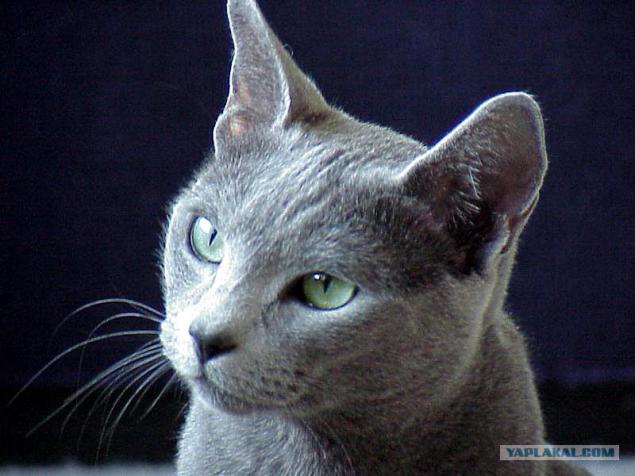
7. Russian blue cat
In cats, this breed is very well expressed hunter instinct - the house is manifested when they lie in wait for a mouse in a few hours. Patience is rewarded in this case with interest. And they love to hunt for flies and moths, during which make astounding leaps in the air.
In Russian blue cat is very beautiful kittens: plump, with a round head, something like the cubs. And the stripes on the fur give the similarity with cubs.
The body from Russian blue cat is medium in size, rather long, strong and graceful. The neck is long and graceful. Cat harmoniously composed, her movements light and beautiful, free, and silver fur on the play gives it an exceptional elegance.
The head of the wedge, rather short with a powerful chin. Pads with a mustache on the face clearly outlined and act, which gives it a special kind.
Ears rather big, thin skin on their fur is closed. The tips of their sharpened.
Straight, medium-length nose is blue-gray hue.
Eyes: Almond - UK standard, round - the American, widely spaced. Their color bright green.
Paws at the Russian blue cat's long, graceful. Small oval brush and blue cushions on them - the UK standard. According to the American - foot round and pink pads.
The tail is quite long, the thickness decreases from the base to the tip.
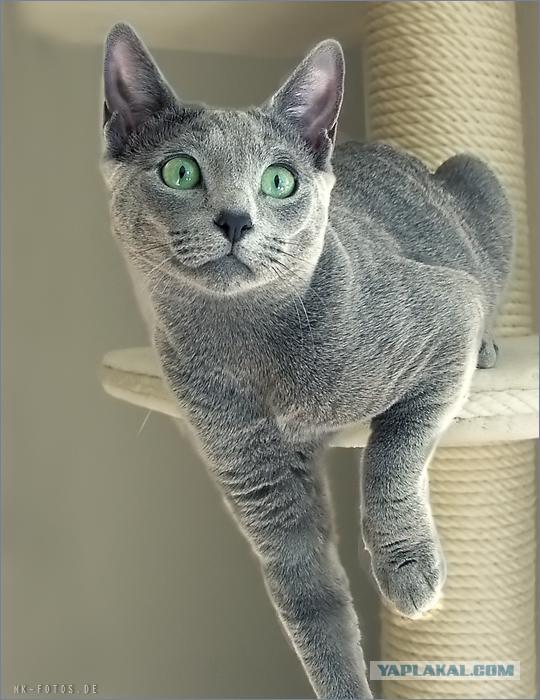
8. Russian blue cat
The true origin of the breed "Russian Blue Cat" is not precisely determined. She has had many different names before called Russian Blue. History tells us that these cats were brought to England from Arkhangelsk sailors. Then they were called - Arkhangelsk. Then the name was changed to "Spanish" and "Maltese» ...
According to history, in the 60 years of the 19th century British sailors who docked at the port of Arkhangelsk, was enchanted by the beauty of cats with bluish-silver color. They are significantly different from the stocky and powerful British cats. Russian blue cats are elegant, graceful and gray-blue color fur - a soft and silky, but denser than the British cats.
With the end of World War II, the number of Russian blue cats is significantly decreased, and their interbreeding with Siamese and British blue almost led to the extinction of species. The main features of Russian blue cats - wool and type - is gradually erased and could disappear altogether. Fortunately, in 1965, breeders decided to try to return the cat to its original form. And then in the US, England and Germany were the Society of the breed Russian blue cat ...
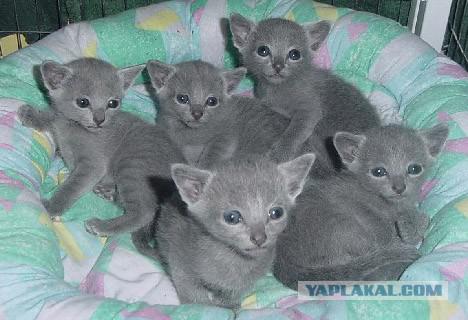
9. Russian Blue Cat
... So now Russian blue cat breed extinction does not threaten.

10. Kuril Bobtail
Not only the tail-pompons endowed nature of the Kuril Bobtail. Life in the harsh conditions of the Kuril Islands demanded cats special courage. Perhaps here there were extraordinary hardness in his eyes, and habits - a fantastic confidence and a phenomenal uptake. Apparently such a complex natural training to some extent, and identified the increased resistance, patience, gave these animals an exceptional intelligence. For many years, living in harsh conditions, wildlife, Kuril Bobtail developed a brilliant quality, unrivaled hunter, quiet animal with a stable psyche, adequate, good-natured, but at the same time, an independent, full of dignity pet. Like all cats, bobtail unusually curious and inquisitive. Wits in conjunction with the boundless energy of this cat, enliven any home.
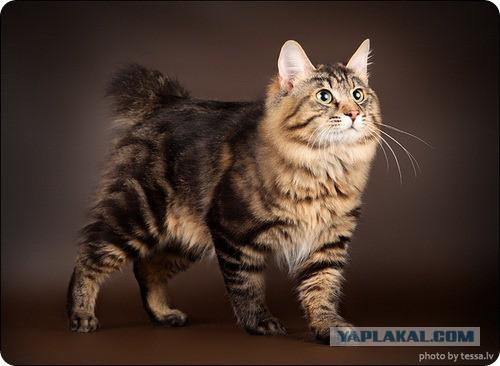
11. Kuril Bobtail
Kuril Bobtail very jumpy due to strong hind legs and strong muscular body, agile and active animals. But it is worth noting that this does not cause trouble jumping hosts - it is more than compensated intelligence and education, characteristic of this breed. You must make sure that the kitten was a space where you will be plenty to play, climb and jump.
The "Kuriles" brilliant intellect! Communication with this cat, observation of its habits, pranks, tricks and pranks, close contact with the animals - all this can bring to the owner with what incomparable pleasure. They have some kind of mysticism, some mystery, inexplicably, but charisma, natural charm of a wild beast.
Some traits Bobtail like dogs: they are easy to learn Oporto (bring a toy or a ball to play with them), suspicious of strangers, can defend their territory, and the owner always advance warning of dangerous situations (known many cases where the Kuril Bobtail insistently warned the man a gas leak, short circuit, and even the approach of the earthquake).

12. Kuril Bobtail
The cat, this has to do with one of the most ancient, naturally formed, cat breeds - Japanese Bobtail. Short-tailed cat, or the Japanese Bobtail, were known in Japan for a long time. Images of these beauties, you can find in various medieval engravings. How they were in Japan? Probably, at first they were Buddhist temple animals. Note that Buddhism in comparison with other religions, and be helped spread a particular temple cats, while not necessarily short-tailed. For example, cats Tibetan monasteries, Balinese and Burmese standard had long tails, and Siamese starotayskie Bobtail were short-tailed. Cats not only exterminated these rodents, but also guarded the temples of the appearance of unexpected visitors. In addition, the cat always considered a sacred animal, she enjoyed the appropriate honors, and was necessary in order to create a special astral atmosphere at the temple grounds. After the spread of Buddhism in eastern states increased the number of temple cats. Migration path proved tortuous and intricate: Egypt - Iran - Turkey - India - Pakistan - China - India - Tibet - Viet Nam - Thailand - Japan - Korea. Then there was nowhere to go. In accordance with the changing social climate and habitat of these animals, which resulted in the emergence of new species. Traditional colors of the temple is a white cat. Perhaps it is these cats were brought to China, Japan and Korea. It is known fact that any rock is influenced not only geographical and climatic conditions, but also the aesthetic environment created in some people. Aesthetically the Japanese view, likely to be more impressed cats whose tails were in the form of chrysanthemums and slanted eyes. Korotkohvostosti widespread gene that always be present at the temple cats (Thai bobtail, Royal Siam). It has become more common in isolation on the islands and was secured by the purposeful selection. The other valuable traits of Japanese cats are the shape and color of the eyes. Particularly popular were tri-colored cat. It was believed that these animals bring home the joy and health and material well-being. Japanese Bobtail peculiar manner for a long time to sit on the hind limbs (kangaroo landing, a peculiar animal with longer relative to the front hind legs) was seen as a gesture, blessing each household.

13. Kuril Bobtail
Over time, the cat of the churches have moved to live in the house to wealthy people. There they were able to provide evidence of wealth and high social status of the owner. The home team is rarely left their pets as legitimate ways to obtain such a cat was practically impossible, and the loss of a family threatened severe adversity. However, during the summer holidays a certain part of separate and independent Japanese cats prefer to escape by denying the freedom and comfort of his home.
Most likely, that is exactly what the Japanese Bobtail breed formed in the Kuriles. In connection with the struggle for existence in the harshest climatic conditions Pampered Japanese breed was significantly adjusted. And the descendants of which have survived in the wild, became the owners of the secondary signs of savagery, for example, the color of wild type - tabby.
Due to the fact that the main color of a Japanese cat (as a reminder of the white temple cat of her ancestors) is white, the color of the wild as a result of a blur of white undercoat, giving a variety of variations of blue and gray marble.
The residence features in the Kuril Islands led to the fact that the claws have lost the ability to get involved, hence there was characteristic Kuril Bobtail clip-clopping sound., Who managed to shake us when our cat ran down the hall. Due to the sharp claws that resemble fishhooks, wild Japanese Bobtail great move on the tree, hunting is not on mere birds and rodents, but also the big fish in the spawning stage. They have lost characteristic of cats fear of water.
Due to the cold climate of these cats became black pads (it's fairly well-known feature of the ruddy cold of the Himalayan type). The black stained lips earlobe and stroking the eye. Cats kept short hair, because it is very convenient to live in the wild, but they have increased in size. In particular, this applies to cats. It is known by the fact that cat have a pronounced sexual dimorphism.
Wild cats - tigers, lions, leopards are much higher than females in size due to the fact that the male has to keep control of a very large area, you need to feed your family. Regarding these characteristic features of the Japanese bobtail as long hind limbs, oriental eye shape, square shape of the body, long neck, short tail-pompom and the head of a triangular shape, they managed to survive, as they do not interfere with the survival of the Kuril Bobtail in the wild.
In the last century there were settlers in the Kuril Islands of Russia, and with them their pets, mostly Siberian cats. Large, fluffy, long-tailed, with a large head round shape and rounded eyes, they had all the signs of domestication. Mingling with wild Japanese Bobtail, they produced a new variation of cats, which is now called the Kuril Bobtail.
That is Kuril Bobtail is a half-breed Siberian cats and wild Japanese bobtail. The shape of the tail may be different, due to the erosion of korotkohvostosti gene, which is characteristic of the Japanese Bobtail.
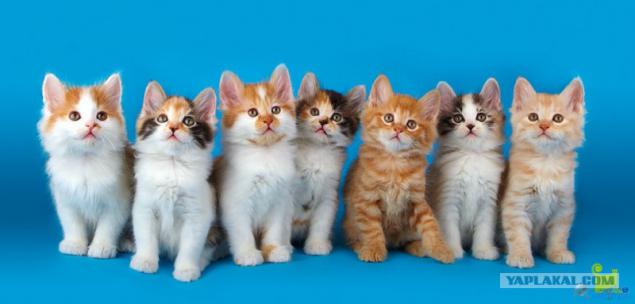
14. Bombay
Bombay - is not much is not enough, the panther in miniature, with a shiny and silky black short and tight to the body hair.
What to do?
Nothing like this.
Source:
As promised, we continue to get acquainted with the world of cats and with all its diversity. For the second part, I picked up the 10 breeds of cats that I am personally interested in, and I think will interest you too. Well, let's go !!!
There will be 48 pictures

1. Neva Masquerade cat
Neva Masquerade cat - a breed of long-haired cats with color-Pointed color and bright blue eyes. In fact, the Neva Masquerade cat - a cat Siberian breed with color, like the color of the Siamese. This breed is the pride of Russian breeders, but in other countries there are many nurseries where they grow Neva Masquerade cats.

2. Neva Masquerade cat
The name of the Neva Masquerade cat was due to his mask on the face, which makes it similar to a beauty, gathered at the masquerade.
The breed is fairly large, the weight of an adult cat is reached about 5-6 kg. Weight adult cat is much more about 8-9 kilograms.
Colors Neva Masquerade cats can be quite different. The most common color of the breed among cats - seal point, ie, light body and dark brown, sometimes almost black, Point (feet, tail, ears, muzzle). Sometimes Neva Masquerade cat color seal point are unique due to darkening in color. Very many people like a shade, and sometimes in the nursery are asked only of "shaded" cat.

3. Neva Masquerade cat
Eyes Neva Masquerade cats can have different colors, from light blue to sapphire blue. Some cats of this breed are rather gentle and good looking and very comely muzzle. At the same time it does not meet the requirements of the breed, but like many fans and owners of Neva Masquerade.
Wool Neva masquerade cat is worthy of attention. Like the Siberian cat Neva Masquerade wool does not cause allergic reactions in sensitive doge allergies. Therefore, if your family has a person suffering from an allergy to wool, and like to have a pet, we recommend that you pay attention to the Neva Masquerade cats. But that's not all resemblance to the coat of Siberian cats. Wool masquerade cat repellent, smooth and does not require special care for themselves, as It never slips and does not form tangles. Another feature of the coat of this breed, inherited from the Siberians available wool collar and panties on his hind legs.
Neva Masquerade cats are very beautiful, and always will cause the admiration of your guests. The animal is aware of its beauty, and will seek to show itself at its best, is shown at the right time, nicely fluffed up and walk next to the guests.
Cats of this breed in the spring molt begins. Animal "undress" a fly takes off unwanted undercoat. By the winter undercoat grows again and again becomes a cat furry and fluffy.

4. Neva Masquerade cat
Neva Masquerade cat is suitable for those who want to have a pet in the house, gentle as a cat and devoted dog who needs a good friend and companion. Cats of this breed is very attached to their owners, like dogs differ a great devotion. The house and furnishings for the Siberian cat Neva stand in the background, the main thing for them - to receive love from their masters. Thus Neva Masquerade cat did not suffer persistence and long-winded, and will constantly climb to his knees for caresses and plaintive meow. This animal senses your mood and come to you only when you are in a good mood and when ready to caress it and play. Loneliness for these animals is not a disaster. You just came from work, little play and cuddle your favorite Neva Masquerade - and this for him is enough.
Neva Masquerade cats are playful and active, but in moderation. Temperament they did not allow excesses. They bring to any home the feeling of comfort and peace, at the same time arranging a physical workout.
Resentful of these cats is completely absent. They will never write to you in the shoes or defecate on the carpet, if you punish them. If a Neva Masquerade cat you would be offended, it just turns back to you and telling you a hint that you are unfair to her. For the care and affection these cats always answer the same coin.
Another remarkable feature of the Neva Masquerade cat: she knows and remembers your name! To lure her to his simple "kitty" you are unlikely to succeed. But when he heard his name, the cat is sure to respond. This breed, unlike many others, understands not just your tone but your words.

5. The Russian blue cat
In Russian blue cat - elegant beautiful body, narrow skull and wedge-shaped head that distinguishes it among the relatives of other breeds. The main feature that distinguishes this breed - short shiny coat uniform blue color with a unique silvery sheen.
Wool cats breed "Russian Blue" differs from other breeds hair: guard hair and undercoat from the Russian blue cats of the same length. On the body the hair is short, like a plush, very thick - skin it is impossible to see through.

6. The Russian blue cat
Russian blue cat - a peaceful, kind and always listen to the owner, but apart from that it is a little bit stubborn and loves freedom. Shy and secretive with strangers and guests. He does not like to wander - closer to her domesticity. Russian blue cats love the most comfortable home, and with family owners are very friendly and sociable. According to legend, the Russian blue cat - a pledge of happiness and prosperity in the house.
Russian blue cats loyal and honest. Like many other relatives, she loves to rub on the legs host purr when stroked her - as she shows affection and love.

7. Russian blue cat
In cats, this breed is very well expressed hunter instinct - the house is manifested when they lie in wait for a mouse in a few hours. Patience is rewarded in this case with interest. And they love to hunt for flies and moths, during which make astounding leaps in the air.
In Russian blue cat is very beautiful kittens: plump, with a round head, something like the cubs. And the stripes on the fur give the similarity with cubs.
The body from Russian blue cat is medium in size, rather long, strong and graceful. The neck is long and graceful. Cat harmoniously composed, her movements light and beautiful, free, and silver fur on the play gives it an exceptional elegance.
The head of the wedge, rather short with a powerful chin. Pads with a mustache on the face clearly outlined and act, which gives it a special kind.
Ears rather big, thin skin on their fur is closed. The tips of their sharpened.
Straight, medium-length nose is blue-gray hue.
Eyes: Almond - UK standard, round - the American, widely spaced. Their color bright green.
Paws at the Russian blue cat's long, graceful. Small oval brush and blue cushions on them - the UK standard. According to the American - foot round and pink pads.
The tail is quite long, the thickness decreases from the base to the tip.

8. Russian blue cat
The true origin of the breed "Russian Blue Cat" is not precisely determined. She has had many different names before called Russian Blue. History tells us that these cats were brought to England from Arkhangelsk sailors. Then they were called - Arkhangelsk. Then the name was changed to "Spanish" and "Maltese» ...
According to history, in the 60 years of the 19th century British sailors who docked at the port of Arkhangelsk, was enchanted by the beauty of cats with bluish-silver color. They are significantly different from the stocky and powerful British cats. Russian blue cats are elegant, graceful and gray-blue color fur - a soft and silky, but denser than the British cats.
With the end of World War II, the number of Russian blue cats is significantly decreased, and their interbreeding with Siamese and British blue almost led to the extinction of species. The main features of Russian blue cats - wool and type - is gradually erased and could disappear altogether. Fortunately, in 1965, breeders decided to try to return the cat to its original form. And then in the US, England and Germany were the Society of the breed Russian blue cat ...

9. Russian Blue Cat
... So now Russian blue cat breed extinction does not threaten.

10. Kuril Bobtail
Not only the tail-pompons endowed nature of the Kuril Bobtail. Life in the harsh conditions of the Kuril Islands demanded cats special courage. Perhaps here there were extraordinary hardness in his eyes, and habits - a fantastic confidence and a phenomenal uptake. Apparently such a complex natural training to some extent, and identified the increased resistance, patience, gave these animals an exceptional intelligence. For many years, living in harsh conditions, wildlife, Kuril Bobtail developed a brilliant quality, unrivaled hunter, quiet animal with a stable psyche, adequate, good-natured, but at the same time, an independent, full of dignity pet. Like all cats, bobtail unusually curious and inquisitive. Wits in conjunction with the boundless energy of this cat, enliven any home.

11. Kuril Bobtail
Kuril Bobtail very jumpy due to strong hind legs and strong muscular body, agile and active animals. But it is worth noting that this does not cause trouble jumping hosts - it is more than compensated intelligence and education, characteristic of this breed. You must make sure that the kitten was a space where you will be plenty to play, climb and jump.
The "Kuriles" brilliant intellect! Communication with this cat, observation of its habits, pranks, tricks and pranks, close contact with the animals - all this can bring to the owner with what incomparable pleasure. They have some kind of mysticism, some mystery, inexplicably, but charisma, natural charm of a wild beast.
Some traits Bobtail like dogs: they are easy to learn Oporto (bring a toy or a ball to play with them), suspicious of strangers, can defend their territory, and the owner always advance warning of dangerous situations (known many cases where the Kuril Bobtail insistently warned the man a gas leak, short circuit, and even the approach of the earthquake).

12. Kuril Bobtail
The cat, this has to do with one of the most ancient, naturally formed, cat breeds - Japanese Bobtail. Short-tailed cat, or the Japanese Bobtail, were known in Japan for a long time. Images of these beauties, you can find in various medieval engravings. How they were in Japan? Probably, at first they were Buddhist temple animals. Note that Buddhism in comparison with other religions, and be helped spread a particular temple cats, while not necessarily short-tailed. For example, cats Tibetan monasteries, Balinese and Burmese standard had long tails, and Siamese starotayskie Bobtail were short-tailed. Cats not only exterminated these rodents, but also guarded the temples of the appearance of unexpected visitors. In addition, the cat always considered a sacred animal, she enjoyed the appropriate honors, and was necessary in order to create a special astral atmosphere at the temple grounds. After the spread of Buddhism in eastern states increased the number of temple cats. Migration path proved tortuous and intricate: Egypt - Iran - Turkey - India - Pakistan - China - India - Tibet - Viet Nam - Thailand - Japan - Korea. Then there was nowhere to go. In accordance with the changing social climate and habitat of these animals, which resulted in the emergence of new species. Traditional colors of the temple is a white cat. Perhaps it is these cats were brought to China, Japan and Korea. It is known fact that any rock is influenced not only geographical and climatic conditions, but also the aesthetic environment created in some people. Aesthetically the Japanese view, likely to be more impressed cats whose tails were in the form of chrysanthemums and slanted eyes. Korotkohvostosti widespread gene that always be present at the temple cats (Thai bobtail, Royal Siam). It has become more common in isolation on the islands and was secured by the purposeful selection. The other valuable traits of Japanese cats are the shape and color of the eyes. Particularly popular were tri-colored cat. It was believed that these animals bring home the joy and health and material well-being. Japanese Bobtail peculiar manner for a long time to sit on the hind limbs (kangaroo landing, a peculiar animal with longer relative to the front hind legs) was seen as a gesture, blessing each household.

13. Kuril Bobtail
Over time, the cat of the churches have moved to live in the house to wealthy people. There they were able to provide evidence of wealth and high social status of the owner. The home team is rarely left their pets as legitimate ways to obtain such a cat was practically impossible, and the loss of a family threatened severe adversity. However, during the summer holidays a certain part of separate and independent Japanese cats prefer to escape by denying the freedom and comfort of his home.
Most likely, that is exactly what the Japanese Bobtail breed formed in the Kuriles. In connection with the struggle for existence in the harshest climatic conditions Pampered Japanese breed was significantly adjusted. And the descendants of which have survived in the wild, became the owners of the secondary signs of savagery, for example, the color of wild type - tabby.
Due to the fact that the main color of a Japanese cat (as a reminder of the white temple cat of her ancestors) is white, the color of the wild as a result of a blur of white undercoat, giving a variety of variations of blue and gray marble.
The residence features in the Kuril Islands led to the fact that the claws have lost the ability to get involved, hence there was characteristic Kuril Bobtail clip-clopping sound., Who managed to shake us when our cat ran down the hall. Due to the sharp claws that resemble fishhooks, wild Japanese Bobtail great move on the tree, hunting is not on mere birds and rodents, but also the big fish in the spawning stage. They have lost characteristic of cats fear of water.
Due to the cold climate of these cats became black pads (it's fairly well-known feature of the ruddy cold of the Himalayan type). The black stained lips earlobe and stroking the eye. Cats kept short hair, because it is very convenient to live in the wild, but they have increased in size. In particular, this applies to cats. It is known by the fact that cat have a pronounced sexual dimorphism.
Wild cats - tigers, lions, leopards are much higher than females in size due to the fact that the male has to keep control of a very large area, you need to feed your family. Regarding these characteristic features of the Japanese bobtail as long hind limbs, oriental eye shape, square shape of the body, long neck, short tail-pompom and the head of a triangular shape, they managed to survive, as they do not interfere with the survival of the Kuril Bobtail in the wild.
In the last century there were settlers in the Kuril Islands of Russia, and with them their pets, mostly Siberian cats. Large, fluffy, long-tailed, with a large head round shape and rounded eyes, they had all the signs of domestication. Mingling with wild Japanese Bobtail, they produced a new variation of cats, which is now called the Kuril Bobtail.
That is Kuril Bobtail is a half-breed Siberian cats and wild Japanese bobtail. The shape of the tail may be different, due to the erosion of korotkohvostosti gene, which is characteristic of the Japanese Bobtail.

14. Bombay
Bombay - is not much is not enough, the panther in miniature, with a shiny and silky black short and tight to the body hair.
What to do?
Nothing like this.
Source:
